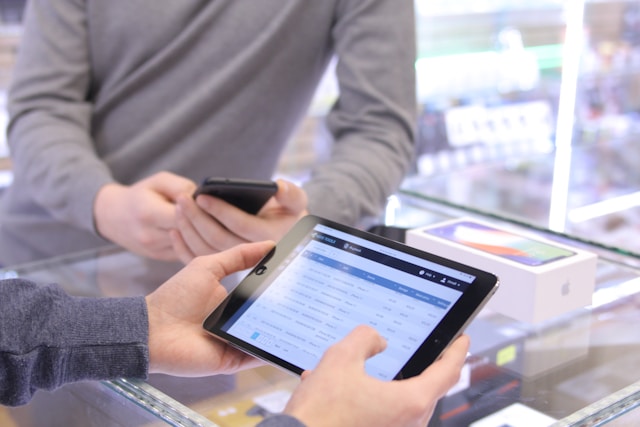Buying Used Electronics: Navigating the world of pre-owned gadgets can feel like a treasure hunt. The potential for incredible savings on high-quality used electronics is immense, but so is the risk of stumbling into a scam. Whether you’re hunting for a recent smartphone, a powerful laptop, or a next-gen console, knowing how to shop wisely is paramount.
This comprehensive guide is packed with professional advice to empower you. We will equip you with the knowledge to confidently find amazing deals, avoid common pitfalls, and ensure your hard-earned money is well-spent. Let’s transform you from a cautious browser into a savvy shopper.
Understanding the online marketplace is your first step towards success. Platforms like papillonlouage, eBay, Facebook Marketplace, Swappa, and Craigslist offer vast inventories of secondhand electronics. Each has its own vibe and safety mechanisms. eBay, for instance, offers strong buyer protection programs, while Facebook Marketplace favors local, cash-based transactions. Recognizing these differences helps you tailor your approach. Your mission is to navigate these digital bazaars with a sharp eye and a healthy dose of skepticism. The perfect device is out there; you just need the right strategy to find it securely.
The importance of thorough research cannot be overstated before you even click “Add to Cart.” Your journey begins not on the listing page, but with knowledge.
What is the average market value for the device you want in its specific condition? What are its common problems or failures? For instance, research whether a certain laptop model is known for a faulty hinge or if a smartphone has a widespread battery issue. Understanding the product’s history and typical price range gives you a powerful benchmark.
This knowledge is your shield against overpaying and your compass for identifying a genuinely good deal amidst a sea of listings.

Image by: unsplash
Your 10-Point Checklist for Buying Used Electronics Safely
1. Meticulously Research the Market Value
- Action: Before you engage with a seller, spend time on various platforms. Check completed listings on eBay to see what the device actually sells for, not just what it’s listed at. Use price comparison tools and check retailer sites for the price of refurbished models.
- Why: An alarmingly low price is the most common red flag for a scam. Conversely, an overly high price means you’re not getting a good deal. Knowing the fair market value empowers you to negotiate effectively and spot fishy listings instantly.
2. Choose Your Buying Platform Wisely
- Action: Select a platform that aligns with your risk tolerance and desired purchase method.
- Swappa: Highly recommended for its strict listing policies and built-in verification. Every IMEI/SN is checked before a sale goes live.
- eBay: Excellent for its robust Money Back Guarantee program, which heavily favors buyers in disputes.
- Facebook Marketplace/Craigslist: Ideal for local deals where you can inspect the item in person. Prefer cash transactions in a safe, public place.
- Papillonlouage
- Why: Different platforms offer different levels of protection. Using a platform with strong buyer protection adds a crucial layer of security to your transaction.
3. Scrutinize the Seller’s Profile and Reputation
- Action: This is a critical step. Check their seller rating, read through feedback comments, and see how long they’ve been active. Be wary of new profiles with zero feedback or a history of negative reviews complaining about “item not as described” or “non-functional.”
- Why: A reputable seller is your best bet for an honest transaction. Their positive reputation is a business asset they are unlikely to risk by scamming you. This due diligence is a powerful trust signal.
4. Analyze the Listing with a Detective’s Eye
- Action: Look for listings with numerous high-resolution, clear photos from every angle. The description should be detailed, honest about any flaws (scratches, dents, battery health percentage), and mention the item’s history. Beware of stock photos or vague descriptions like “works perfectly.”
- Why: A genuine seller wants to be transparent to avoid future disputes. A lack of detail or effort in the listing often indicates a lack of care or a desire to hide something.
5. Always Ask Specific, Pointed Questions
- Action: Don’t just ask “Is it working?” Ask precise questions:
- “What is the battery health percentage?”
- “Can you provide the IMEI or serial number so I can verify it’s not blacklisted?”
- “Are there any scratches on the screen? Can you send a photo of the screen powered off?”
- “Why are you selling this item?”
- “How to Buying Used Electronics?”
- “Does it come with the original charger, box, and accessories?”
- Why: Detailed questions force the seller to provide specific information. Hesitant, vague, or angry responses are major red flags. A legitimate seller will happily provide this info.
6. Verify the Device is Not Stolen or Blacklisted
- Action: This is non-negotiable for phones and tablets. Once a seller provides the IMEI or serial number (usually found in the device’s settings or on the original box), use a free online IMEI checker to verify its status. It will tell you if the device has been reported lost, stolen, or is locked to a carrier.
- Why: Buying Used Electronics device means you’ve bought a very expensive paperweight. It cannot be activated on any major carrier network. This simple check saves you from total financial loss.
7. Insist on Using Secure Payment Methods
- Action: NEVER wire money or use irreversible payment apps for shipped items. For online purchases, use PayPal Goods & Services or a credit card via a platform’s checkout system. These methods offer purchase protection and allow you to file a dispute if the item is not as described.
- Why: Secure payment methods are your ultimate safety net. They ensure you have recourse if something goes wrong, giving you the confidence to dispute fraudulent charges.
8. Thoroughly Test the Device Upon Receipt
- Action: When the item arrives, record a video of yourself unboxing it. Immediately test every single function:
- Phones/Tablets: Test speakers, microphone, cameras (all lenses), Bluetooth, WiFi, cellular connection, touchscreen responsiveness, and all buttons.
- Laptops: Test the keyboard, trackpad, USB ports, display, speakers, webcam, and charge cycle.
- Consoles: Test disc drive, controller connectivity, all ports, and network connection.
- Why: This documented testing process provides concrete evidence if you need to file a claim for a refund. It proves the item arrived damaged or faulty.
9. Understand Return Policies and Buyer Protection
- Action: Before purchasing, read the platform’s buyer protection policy thoroughly. Know how many days you have to inspect the item and what the process is for initiating a return or dispute. Save all communication with the seller within the platform’s messaging system.
- Why: Knowledge of the rules ensures you act within the required timeframe and provide the necessary evidence to win a claim, making the process smooth and stress-free.
10. Trust Your Gut Instinct
- Action: If a deal feels too good to be true, it almost always is. If the seller is pressuring you to decide quickly, refusing to answer questions, or suggesting payment methods outside the platform, walk away immediately.
- Why: Your intuition is a powerful scam detection tool. There will always be another deal. It is far better to miss out on a potential bargain than to lose your money to a confirmed scam.
Securing your fantastic buying used electronics deal is the final reward for your diligence. Once you’ve tested the device and are satisfied, you can enjoy your new gadget with peace of mind. You have successfully navigated the potential dangers and emerged victorious. The skills you’ve applied research, verification, and secure payment are invaluable for every future online purchase. You are now part of a savvy community of shoppers who know that with the right approach, buying used electronics is not a risk, but a remarkably smart financial decision.
The journey to finding premium buying used electronics is a skill that pays for itself over and over. The secondhand market is abundant with opportunities to own excellent technology at a fraction of the original cost. By following this detailed blueprint, you systematically eliminate risk and stack the odds heavily in your favor. You learn to see past clever scams and identify genuine sellers offering honest value.
Also Read: Sell Your Car Quickly: The Ultimate Guide to Classified Ads Success
Conclusion: Shop with Confidence and Intelligence
Buying Used Electronics
Buying used electronics online doesn’t have to be a nerve-wracking gamble. It’s a strategic process that, when done correctly, is incredibly rewarding. By internalizing these ten essential tips from intense research and seller vetting to IMEI checks and secure payments, you build an impenetrable defense against fraud. You are no longer an easy target; you are an informed consumer. So, go forth with this knowledge. Embrace the hunt, trust the process, and unlock a world of incredible tech deals without fear. Your perfect pre-owned device is waiting for you to find it the smart way.
-
What is the safest way to pay for used electronics online?
The safest method is always to use a secure platform’s payment system (like eBay checkout) or PayPal Goods & Services. These offer strong buyer protection, allowing you to dispute the payment if the item arrives broken, faulty, or different from its description.


